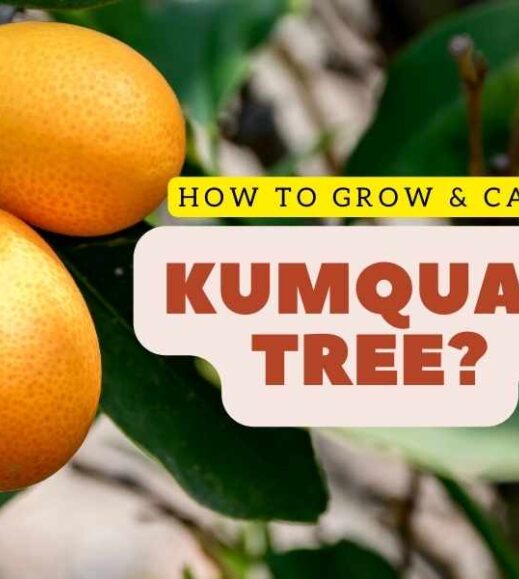Propagate | Soil | Light | Water | Temperature | Humidity | Potting | Pruning | Fertilize | Pest Control | FAQs
Those who prefer the sweetness of oranges to the tartness of lemons will love the Kumquat tree for its delicious citrus fruits.
From growing and caring for Kumquats to enjoying their unique flavor, this guide will provide everything you need to know about Kumquats.
Kumquats are worth trying whether you want a new addition to your garden or want to try something different in your next glass of lemonade. Thanks for reading, and we hope you enjoy learning more about Kumquats.
Where to buy Kumquat tree? Kumquat tree for sale
If you are wondering kumquat where to buy? You can buy live Kumquat tree online or in several plant nurseries and home depot stores.
Kumquat tree varieties
Kumquats, a citrus fruit native to East Asia, come in various flavors and appearances. There are several Kumquat varieties and types available in the market some of the most common ones are:
- Kumquat Nagami
- Kumquat Marumi
- Kumquat Meiwa
- Kumquats Jiangsu
- Hong Kong Kumquats
- Japanese kumquat
- Kumquat fukushu
The most common variety in stores is the Kumquat Nagami, which has an oblong shape and few seeds. Centennial variegated kumquat is a common variegated type of Nagami Kumquat.
Other popular varieties include the Kumquat Marumi, which is rounder than the Kumquat Nagami and not as sweet, and the Kumquat Meiwa, which is sweeter and juicier than the Nagami but more expensive to find.
Kumquats Jiangsu are distinguished by their round leaves, while Hong Kong kumquats are known for their small, bitter fruit.
Centennial Variegated Kumquats have compact growth and variegated colors on their leaves, while Malayan Kumqauts (also known as hedge limes) resemble lime quats. Kumquats are often used in marmalades and jams or eaten raw as a snack.
Kumquat Bonsai: Can you Bonsai Kumquat tree?
Many people like to create Kumquat bonsai. Kumquat Nagami is the most commonly used variety in creating Kumquat bonsai.
Planting Kumquat trees
There are many ways to prepare kumquats. They are citrus fruit often used as marmalade and jam.
The first thing you need to know before planting a kumquat tree is a few things.
The trees they grow on are attractive and can be kept small, so they're perfect for growing in pots. You can find a step-by-step guide to planting kumquat trees here.
According to the USDA, Kumquat tree grows best in Hardiness Zones 9-10.
When to plant Kumquat trees?
When planting a kumquat tree, late winter or early spring is the best time. This gives the tree a chance to become established before summer.
Late winter is an excellent time to plant a tree if you live in a warm climate.
In cooler climates, it is best to wait until early spring if you live in a more relaxed area.

Looking for easy-to-maintain, low-budget front-yard landscaping ideas?
Where to plant Kumquat trees?
The kumquat tree is a must-have for those who love citrus fruits. These trees are relatively small so that they can be grown in pots on a patio or balcony. They can also be planted in the ground, as long as you choose the right spot.
If you're planting the tree outside, look for a sunny spot with well-drained soil. That's important because kumquats don't like to sit in water.
Their roots can rot if they're constantly wet, so you must ensure the water will drain away quickly. You also don't want to plant them in dense clay soil because that can hold too much water and cause problems.
If you're potting the tree, choose a pot with drainage holes three times the size of the root ball.
That will help ensure that the roots don't get waterlogged. With a little care, your kumquat tree will thrive and provide you with delicious fruit for years.
How to plant Kumquat trees?
Once you've selected the perfect spot for your kumquat tree, it's time to get it in the ground (or pot). Follow these steps for planting kumquat trees:
Before planting the tree, ensure the hole is twice the width and twice the depth of the root ball. Loosen the roots before planting.
2. Gently backfill the hole with soil, careful not to pack it too tightly around the roots. Water regularly until established.
3. Mulch around the tree's base with shredded bark or leaves to help retain moisture and control weeds.
4 . Fertilize once per month using a citrus fertilizer according to package directions.
5 . Prune away any dead or damaged branches as needed.
Follow these tips, and you'll be on your way to growing healthy kumquat trees that produce delicious fruit!
Kumquat tree care
Like other citrus trees, kumquat trees require regular care to ensure a plentiful harvest. Keep the following tips in mind when caring for your kumquats:
Light
If you're thinking of growing a kumquat tree, you'll need to ensure it gets plenty of light.
To grow kumquats, it is recommended to plant them close to your brightest window or set them under grow lights.
Bright, indirect sunlight will not kill kumquats, but they will be less productive.
Soil
Kumquat trees are a delightful addition to any garden, but it's essential to understand the soil requirements before you plant one.
Most citrus trees prefer loamy soils that are moist and well-draining, with a pH of 6.5-7.5. Kumquats are no exception – they will do best in soils with a slightly acidic to neutral pH.
If your soil is heavy clay, it can be difficult for the roots to get enough oxygen, leading to root rot. So if you have clay soil, consider planting your kumquat tree in a raised bed or container filled with amended soil.
Water
Kumquats may be tiny, but they are mighty! Not only do they pack a nutritional punch, but these little citrus fruits also require a surprising amount of water to grow well. Let's take a closer look at kumquats and their water needs.
Kumquats need a good, deep watering once a week to ensure the soil stays moist. During periods of extreme heat or dryness, they may need two waterings per week. Water your kumquat tree slowly and deeply until the moisture reaches 8-12 inches below the surface. This will encourage healthy root growth and prevent damage to the delicate tree.
It's important to note that kumquats are particularly sensitive to inconsistent watering patterns, so try to be consistent with your watering schedule. Watering too much or too little at any given time can stress the tree and produce weak fruit. Keep an eye on the soil moisture levels and adjust your watering routine accordingly.
Finally, keep the soil weed-free and mulched around the tree to help retain moisture. Adding a 2-3 inch layer of organic mulch will also provide insulation in colder climates while helping to reduce water loss from evaporation. With adequate water and care, your kumquat tree will produce delicious, nutrient-packed fruit for years to come!
Temperature and humidity
Although kumquats can survive cold weather, they don't like it. They prefer warm weather and humidity levels between 50 and 60 percent.
During the winter, ensure that the air is humidified with a humidifier or by placing the container on a tray containing pebbles and water if you're keeping your kumquat tree indoors. Your kumquat tree will be happier if the air is humidified in this way.
Fertilizer
Even though kumquat trees are relatively low-maintenance, there are some things you should do to ensure they grow well. One of those things is fertilizing them.
Most people wait until springtime to start fertilizing their kumquat trees, but it's best to wait until after the tree has bloomed. You shouldn't fertilize at all during the winter months. Once you've planted your tree, use a citrus fertilizer according to the instructions on the label. Be careful not to overfertilize, as that can harm your tree.
Common pests and Kumquat tree plant diseases
When growing kumquats, you should be aware of several pests and diseases, but they are generally healthy and low-maintenance.
When planted in poorly drained soil, kumquats are susceptible to root rot and prone to flooding. Choose a planting site that has good drainage and avoids overwatering to prevent root rot.
Even though aphids can be troublesome, natural predators usually keep them at bay. Horticultural oils can aid in their control.
Kumquats are susceptible to common indoor pests such as spider mites and scale, which can be easily controlled with a bit of care and attention.
Pollination
A flower's male anthers transfer pollen to the stigma in pollination.
Kumquats are self-pollinating, so they do not require insects for pollination. They can be pollinated by wind, water, or animals.
Kumquats can fruit on their own without any cross-pollination.
Pruning
Pruning not only helps keep the tree healthy but also encourages new growth. There are several techniques you can use when pruning a kumquat tree:
Remove any dead or diseased branches. The sucker should be removed if it sprouts below the graft bud. When the tree is tiny, pinch off the tips of the shoots.
The best time to prune kumquats for shaping is after the fruit has been harvested but before the flowers appear the following spring. Pruning kumquats may seem daunting, but your tree will flourish with some care and attention!
Propagating Kumquats
Fruit-bearing branches are grafted onto orange and grapefruit rootstocks during the propagation process for Kumquats.
If you want to produce Kumquats from seed, you need to consider the following: since seeds do not produce viable trees, buying grafted trees from nurseries is more accessible than trying this technique yourself.
But for the green-thumbed among us, propagating kumquats can be a fun and rewarding experience.
So if you're up for the challenge, read on for some tips on propagating your kumquat tree!
Potting and repotting Kumquats
With a bit of care and attention, potting and repotting a kumquat tree does not have to be a stressful process.
You can use any general-purpose potting mix as long as it is well-draining. Kumquats do not care what potting mix you use as long as it is well-drained.
In the next step, you must decide when it is appropriate to repot the plant. When repotting Kumquats, you should use a container slightly larger than the original one and do so as soon as the leaves appear in spring.
Ensure you don't water the plant for a few days after repotting, so the soil can settle around the roots. When ready to report, use your fingers to loosen the roots.
And that's it! With some planning and TLC, potting and repotting kumquats can be a breeze.
How to eat Kumquat? What are Kumquat fruit benefits?
There are several things you can do with Kumquat fruits. You can prepare several kumquat recipes using Kumquat fruit mentioned below. There are several kumquat health benefits.
- kumquat drink such as kumquat tea or kumquat honey tea, kumquat juice and kumquat lemonade
- kumquat alcohol (kumquat wine)
- kumquat curd
- kumquat pickle (kumquat chutney)
- kumquat cake
- kumquat jam, kumquat marmalade and kumquat jelly
- kumquat puree
- kumquat pie
- candied kumquats
- dried kumquat
FAQs
Are Kumquats easy to grow?
Providing a Kumquat tree with the right amount of light and water will make it relatively easy for you to grow it.
What is the growing time for Kumquats?
Fruit may not be produced by a young kumquat tree for at least two seasons after it becomes established.
Can the Care Tips for Growing a Plumeria Plant Also Apply to Growing a Kumquat Tree?
Yes, the expert tips for plumeria care can also be applied to growing a kumquat tree. Both plants thrive in well-draining soil, plenty of sunlight, and regular watering. Additionally, they benefit from occasional fertilization and protection from extreme temperatures. By following these tips, you can successfully cultivate both plants.
Can you grow a Kumquat tree indoors?
Not only do kumquat trees grow well in containers, but they can also thrive indoors with the right amount of light.

How to master gardening? Download these essential home and gardening ebooks today!


















